Are you ready to unleash the full potential of your gardening skills? In this essential guide, I will walk you through the most effective gardening techniques that will transform your garden into a paradise of lush foliage and vibrant blooms.
Gardening is not just a hobby; it’s an art that requires skill, knowledge, and passion. Whether you’re a beginner or an experienced gardener, understanding the fundamentals of gardening techniques is crucial to ensure the success of your plants and create a beautiful and thriving garden. This comprehensive guide will cover everything you need to know, from basic tips for soil preparation and planting to advanced techniques for expert gardeners.
Key Takeaways:
- Learn the essential gardening techniques to create a beautiful and thriving garden.
- Discover the benefits of organic gardening and how to implement sustainable practices.
- Explore advanced techniques to take your gardening skills to the next level.
- Create a comprehensive garden plan that optimizes space and layout.
- Choose the right plants for your garden to ensure success.
With the knowledge gained from this guide and the additional resources provided, you’ll be equipped with the tools to master your green thumb and create a garden that will impress and delight for years to come.
Unearth the Secrets of Successful Gardening
Whether you’re a novice or a seasoned green thumb, mastering the basics is crucial to achieving gardening success. In this section, I will share invaluable gardening tips and techniques that will lay the foundation for your gardening journey.
One of the first things to consider is soil preparation. Good soil is the cornerstone of a thriving garden. Start by testing your soil’s pH levels and nutrient content. This will help you determine the necessary amendments to improve soil quality. Add organic matter such as compost or aged manure to enrich the soil and enhance its structure. Proper soil preparation provides a healthy environment for your plants to grow.
Another important technique is proper watering. Many gardeners make the mistake of overwatering or underwatering their plants. To avoid this, water your plants deeply, ensuring that the water reaches the roots. This encourages deeper root growth and makes your plants more resilient. Be mindful of the specific watering needs of different plants, as some may require more frequent watering than others.
Pest control is also essential for a successful garden. Rather than relying on chemical pesticides, opt for natural solutions. Companion planting, for example, involves planting certain crops together to deter pests and attract beneficial insects. Additionally, regularly inspect your plants for signs of pests or diseases and take appropriate action to protect your garden.
Remember, these are just a few of the many gardening tips and techniques that will help you achieve gardening success. By implementing these practices and continuously expanding your knowledge, you will become a master of cultivating a flourishing garden.

| Tip | Description |
|---|---|
| 1 | Test your soil’s pH levels and nutrient content. |
| 2 | Add organic matter to enrich the soil. |
| 3 | Water your plants deeply, ensuring water reaches the roots. |
| 4 | Implement natural pest control methods. |
Nurturing Nature the Organic Way
Embrace the power of nature and cultivate a garden that flourishes with vitality using organic gardening techniques. In this section, I will guide you through the best practices for nurturing your plants and protecting the environment.
Organic gardening focuses on working in harmony with nature, avoiding synthetic chemicals, and embracing natural methods to promote plant health and soil fertility. By implementing these techniques, you can create a thriving garden that not only benefits your plants but also supports the overall ecosystem.
One of the key principles of organic gardening is maintaining healthy soil. By enriching the soil with organic matter like compost, you provide essential nutrients for plant growth and encourage beneficial microbial activity. This improves soil structure, aids in moisture retention, and promotes healthy root development.
Another important aspect of organic gardening is pest management. Instead of relying on chemical pesticides, consider natural alternatives such as companion planting, beneficial insects, and physical barriers. This approach reduces the negative impact on beneficial insects and pollinators while still effectively controlling pests.
Benefits of Organic Gardening
Organic gardening offers numerous benefits, both for the gardener and the environment. By avoiding synthetic chemicals, you reduce the risk of chemical exposure and create a safer environment for yourself, your family, and your pets. Additionally, organic practices help preserve biodiversity by supporting beneficial insects, birds, and other wildlife.
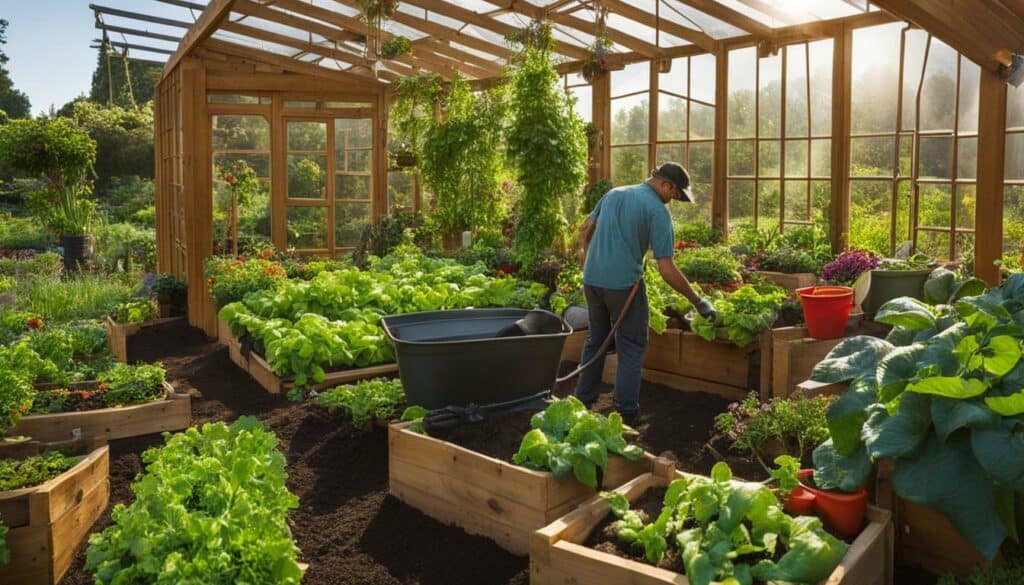
| Best Organic Gardening Techniques | Benefits |
|---|---|
| Composting | Improves soil fertility and structure |
| Mulching | Retains moisture, suppresses weeds, and regulates soil temperature |
| Crop rotation | Prevents pests and diseases and maintains soil health |
| Companion planting | Naturally repels pests and attracts beneficial insects |
Whether you are a beginner or an experienced gardener, incorporating organic gardening techniques into your practice can lead to healthier plants, a more sustainable garden, and a deeper connection to the natural world. Let’s harness the power of nature and create a flourishing garden that thrives for years to come.
Advanced Techniques for Expert Gardeners
For those seeking to elevate their gardening skills to an expert level, this section will unlock the secrets to advanced techniques that will challenge and expand your gardening horizons. Whether you’re a seasoned gardener ready to explore new frontiers or a dedicated enthusiast looking to take your green thumb to the next level, these advanced gardening techniques will enhance your gardening experience and yield remarkable results.
1. Grafting: The Art of Plant Fusion
Grafting is a technique that allows you to combine different plant varieties into one, creating hybrid plants with the best traits of each. It involves joining the tissues of two plants, typically a rootstock and a scion, to create a single plant that combines the root system of one with the desired qualities of the other. This technique is particularly useful for fruit trees, roses, and ornamental plants. By mastering grafting, you can create unique and extraordinary plants that are tailored to your specific preferences.
2. Propagation: Creating New Life from Existing Plants
Propagation is the process of reproducing plants from a parent plant, enabling you to expand your garden without having to start from seeds. There are various methods of propagation, including stem cuttings, division, layering, and grafting. Each method has its advantages and is suitable for different types of plants. By mastering the art of propagation, you can multiply your favorite plants, share them with others, and create a diverse and thriving garden.
| Propagation Method | Best Plants |
|---|---|
| Stem Cuttings | Herbaceous plants, succulents, some shrubs |
| Division | Perennials, grasses, bulbs |
| Layering | Climbing plants, shrubs |
| Grafting | Fruit trees, roses, ornamental plants |
“Propagation allows you to create an abundance of plants and share the beauty of your garden with others.”
3. Pruning: Shaping and Enhancing Plant Growth
Pruning is a vital technique that promotes healthy growth, controls the size and shape of plants, and enhances their overall appearance. By selectively removing branches, shoots, or leaves, you can influence the growth pattern, increase flowering, and improve the structural integrity of plants. Proper pruning techniques vary depending on the type of plant, such as fruit trees, shrubs, or roses. With the mastery of pruning, you can sculpt your garden into a work of art and optimize the health and productivity of your plants.
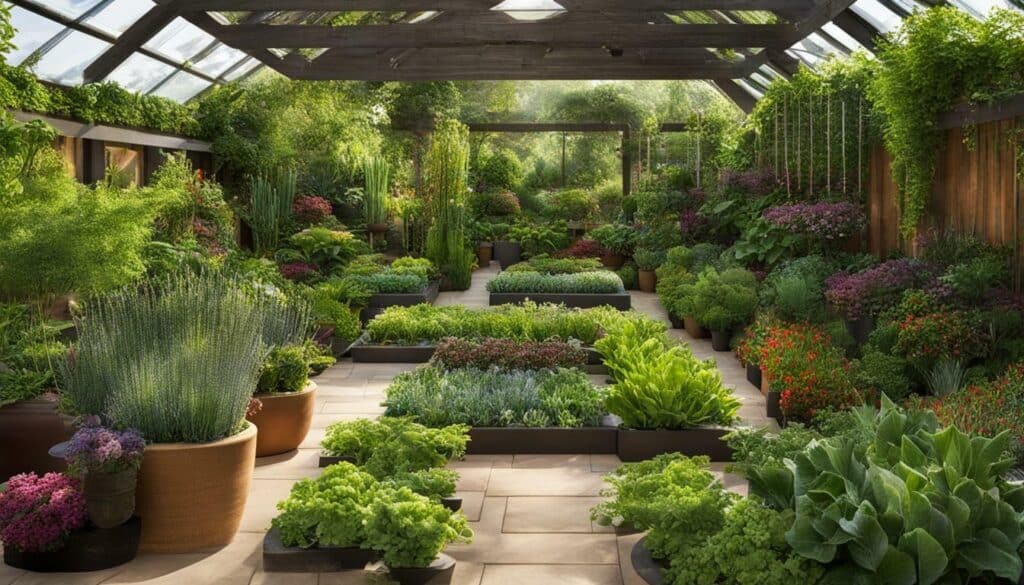
These advanced gardening techniques are just the tip of the iceberg when it comes to expanding your expertise as a gardener. Experimenting with these methods will provide you with endless possibilities and open doors to creativity. So, embrace the challenge, push the boundaries of your gardening skills, and witness the transformative power of advanced techniques in your flourishing garden.
Crafting Your Garden Plan
A well-thought-out garden plan is the backbone of a successful garden. In this section, I will share my expert tips on crafting a garden plan that will help you make the most of your gardening efforts.
When creating your garden plan, it’s important to consider factors such as space, sunlight, and plant selection. Start by assessing the available space in your garden and determine how you can maximize it. Consider the layout and arrangement of your plants to ensure they have enough room to grow and thrive.
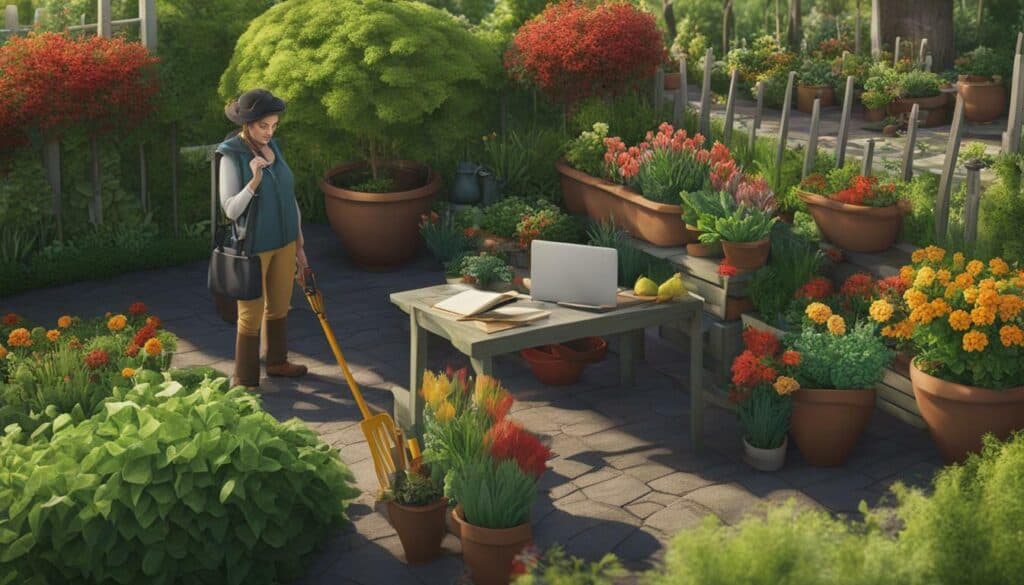
| Key Elements of a Garden Plan | Benefits |
|---|---|
| Assessing sunlight | Determining the best spots for sun-loving or shade-loving plants |
| Planning for seasonal changes | Ensuring a vibrant garden throughout the year with plants that bloom in different seasons |
| Creating a diverse and visually appealing garden | Incorporating a variety of plant species, colors, and textures for an aesthetically pleasing garden |
To help you visualize your garden plan, create a detailed layout that includes the placement of different plant varieties, pathways, and any additional garden features like trellises or seating areas. This will give you a clear idea of how your garden will look and allow you to make adjustments as needed.
Expert Tip: Consider Companion Planting
Companion planting involves planting different plant species together to enhance growth and deter pests. For example, planting marigolds alongside tomatoes can help repel harmful insects while promoting healthy growth.
- Marigolds repel nematodes and other pests that can damage tomato plants.
- Tomatoes provide shade for the marigolds, preventing them from becoming overheated.
By incorporating companion planting into your garden plan, you can create a natural and harmonious balance that benefits your plants.
A well-crafted garden plan sets the foundation for a thriving and beautiful garden. Take the time to carefully consider your space, sunlight, and plant selection, and don’t forget to include companion planting for added benefits. With a solid plan in place, your gardening efforts will yield impressive results.
Choosing the Right Plants: The Key to Gardening Success
Your choice of plants can make or break your gardening endeavor. In this section, I will equip you with the knowledge and tools to choose the right plants that will flourish in your garden.
When selecting plants for your garden, it’s important to consider factors such as climate, soil conditions, and sunlight exposure. Different plants have specific requirements, and by understanding these needs, you can create an environment where they can thrive.
To help you make informed choices, here are some essential plant keys to keep in mind:
| Plant Key | Description |
|---|---|
| Hardiness Zone | Determine the appropriate plants for your region based on the USDA Hardiness Zone Map. This map divides the United States into different zones based on average temperatures, helping you select plants that can withstand local climatic conditions. |
| Plant Compatibility | Consider the compatibility of plants when planning your garden. Some plants benefit from being planted together, while others may inhibit each other’s growth. Companion planting can promote healthy growth and natural pest control. |
| Specific Plant Characteristics | Pay attention to the specific requirements of individual plants, such as their preferred soil type, water needs, and sunlight preferences. Some plants thrive in full sun, while others prefer partial shade. Understanding these characteristics will help you create the ideal conditions for each plant. |
By using these plant keys as a guide, you can select a diverse range of plants that will complement each other and flourish in your garden. Remember, a well-chosen selection of plants can create a vibrant and thriving garden that brings you joy and satisfaction.
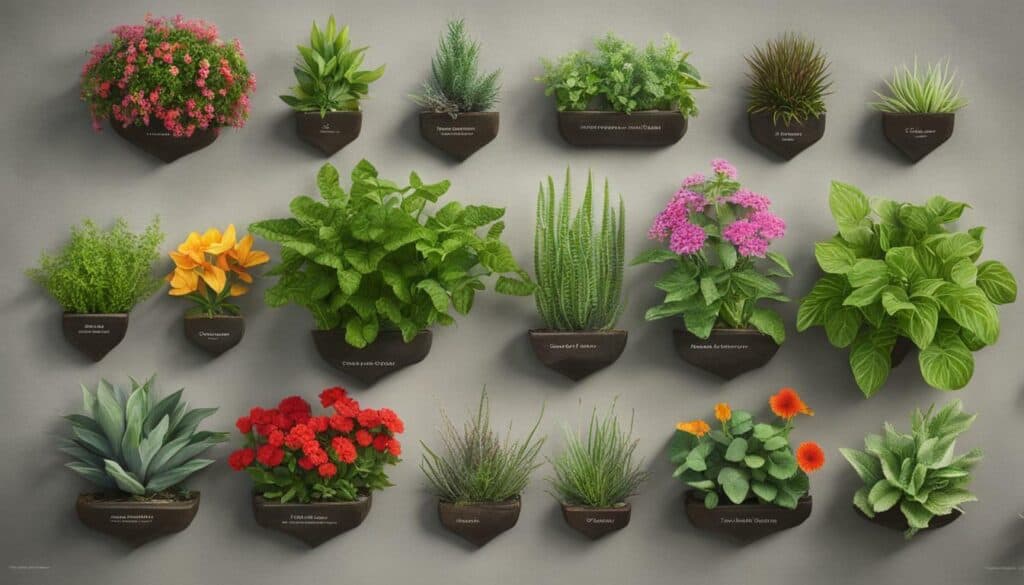
Continue reading to discover more gardening tips and techniques in the following sections of our comprehensive guide.
Conquering Local Weather Challenges
Mother Nature can be unpredictable, but with the right techniques, you can conquer the challenges posed by your local weather conditions. In this section, I will share invaluable tips to help you navigate and overcome weather-related obstacles in your garden.
When it comes to gardening, understanding the impact of weather on your plants is crucial. Extreme temperatures, excessive rainfall, and frost can all wreak havoc on your garden if you’re not prepared. Here are some essential tips to handle local weather challenges:
- Protecting your plants from frost: Extreme cold temperatures can damage or even kill your delicate plants. Cover them with frost blankets or sheets to insulate them from the freezing weather.
- Dealing with drought: In regions prone to drought, water conservation is key. Consider installing a drip irrigation system or using mulch to retain moisture in the soil.
- Managing extreme heat: High temperatures can stress plants and lead to wilting or sunburn. Provide shade using trellises or shade cloth and water deeply in the early morning or late evening to help your plants stay hydrated.
- Preventing damage from heavy rainfall: Excessive rain can lead to waterlogged soil and root rot. Ensure proper drainage in your garden by using raised beds or adding organic matter to improve soil structure.
Remember, every region has its unique weather challenges, so it’s important to adapt these tips to your specific climate. By staying informed and being proactive, you can create a garden that thrives despite the unpredictable weather.

Testimonial: Weatherproofing my Garden
“I live in an area with harsh winters, and my plants used to suffer every year. But after implementing the tips I learned in this section, I’ve successfully protected my garden from freezing temperatures and heavy snowfall. Now, I can enjoy a thriving garden all year round!” – Emily S.
Now that you’re equipped with the knowledge to tackle weather challenges, let’s move on to the next section where we’ll explore delightful recipes using homegrown goodness from your garden.
Delightful Dishes from Your Garden: Recipes for Homegrown Goodness
Unleash your inner chef and savor the flavors of your garden with these sensational recipes that transform homegrown vegetables, fruits, and flowers into delectable dishes. Whether you’re a seasoned gardener with a bountiful harvest or just starting with a few potted plants on your balcony, these recipes will inspire you to get creative in the kitchen.
From vibrant salads bursting with freshly picked greens to hearty soups that showcase the flavors of your ripest tomatoes, there’s a recipe for every palate. Enjoy the sweetness of homegrown berries in a refreshing summer dessert or elevate your comfort food with zucchini fritters that celebrate the abundance of your vegetable patch.
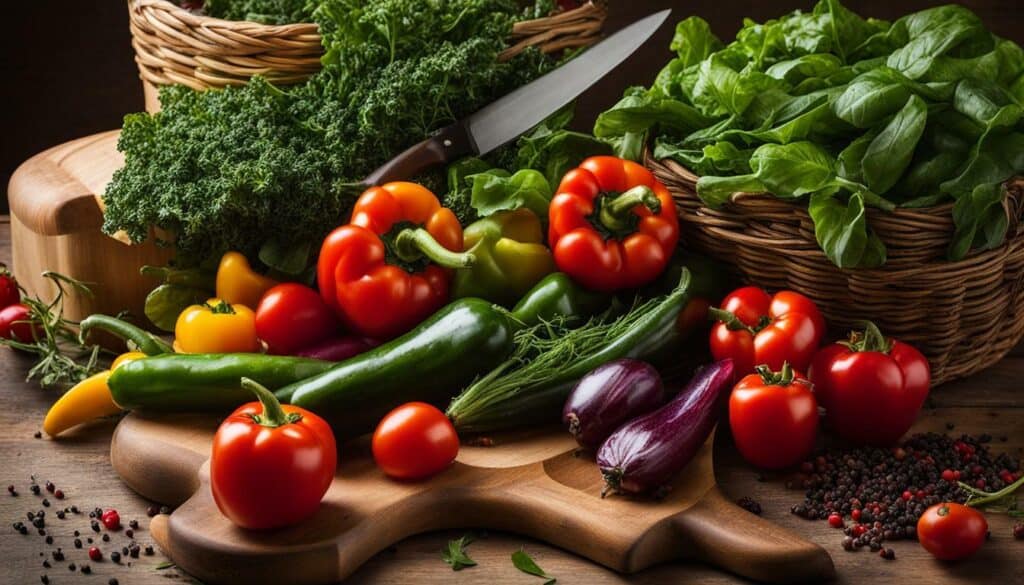
| Recipe | Ingredients | Instructions |
|---|---|---|
| Fresh Caprese Salad | Tomatoes, mozzarella cheese, fresh basil, olive oil, balsamic vinegar, salt, and pepper | 1. Slice tomatoes and mozzarella cheese. Arrange them on a plate. 2. Scatter fresh basil leaves over the slices. 3. Drizzle with olive oil and balsamic vinegar. 4. Season with salt and pepper to taste. 5. Serve immediately. |
| Summer Berry Smoothie | Mixed berries, Greek yogurt, honey, almond milk, ice | 1. Combine all ingredients in a blender. 2. Blend until smooth and creamy. 3. Pour into a glass and serve chilled. |
| Zucchini Fritters | Zucchini, flour, egg, garlic, onion, Parmesan cheese, salt, pepper, olive oil | 1. Grate zucchini and squeeze out excess moisture. 2. In a bowl, combine grated zucchini, flour, egg, minced garlic, finely chopped onion, grated Parmesan cheese, salt, and pepper. 3. Mix until well combined. 4. Heat olive oil in a skillet over medium heat. 5. Drop spoonfuls of the zucchini mixture into the skillet and flatten with a spatula. 6. Cook until golden brown on both sides. 7. Remove from the skillet and drain on a paper towel. 8. Serve warm with your favorite dipping sauce. |
These recipes are just a taste of what you can create using the fruits of your labor. From simple snacks to impressive main courses, let your garden inspire your culinary creations. So put on your apron, grab your basket, and get ready to enjoy the delicious rewards of your garden!
Enhance Your Gardening Skills with Comprehensive Resources
As you delve deeper into the world of gardening, there are numerous resources available to support your learning and provide additional insights. In this section, I will recommend a selection of valuable resources that cover a range of topics to enhance your gardening skills.
If you’re interested in understanding the science behind plants and their growth, “Plant Physiology: A Comprehensive Guide” by Peter H. Raven is an excellent choice. This book covers the fundamental principles of plant physiology and explores topics such as photosynthesis, respiration, and nutrient absorption. It will deepen your understanding of how plants function and help you make informed decisions when it comes to their care and cultivation.
When it comes to understanding the impact of weather and climate on your garden, “The Weather and Climate of Your Garden” by Thomas L. Mote is a valuable resource. This book provides practical insights into how different weather patterns can affect your plants and offers strategies for mitigating their effects. It covers topics such as temperature extremes, rainfall patterns, and wind conditions, allowing you to adapt your gardening techniques accordingly.
If you’re looking to create a garden that is resistant to deer and other garden pests, “Deer-Resistant Landscaping: Proven Advice and Strategies for Outwitting Deer and 20 Other Pesky Mammals” by Neil Soderstrom is a must-read. This comprehensive guide offers practical tips and techniques for deterring unwanted wildlife without resorting to harmful chemicals. It includes information on plant selection, fencing, and other natural deterrents, ensuring that your garden remains beautiful and flourishing.
For those interested in indoor gardening, “The Indoor Plant Bible: The Essential Guide to Choosing and Caring for Indoor, Greenhouse, and Patio Plants” by Dorte Nissen is an invaluable resource. This book covers everything you need to know about selecting, growing, and maintaining plants indoors. From lighting requirements to temperature and humidity control, it provides expert advice and troubleshooting tips to help you create a thriving indoor garden all year round.
Lastly, if you’re eager to extend your gardening season and grow your own food during the winter months, “Winter Gardening in the Maritime Northwest: Cool Season Crops for the Year-Round Gardener” by Binda Colebrook is a fantastic resource. This book focuses on cold-weather gardening techniques and offers practical guidance on selecting, planting, and harvesting a variety of winter crops. It will help you make the most of your garden year-round and enjoy fresh, homegrown produce even in the coldest months.
With these diverse resources at your disposal, you can expand your gardening knowledge and improve your skills. Whether you’re a beginner or an experienced gardener, these books will provide valuable insights and practical advice to help you achieve gardening success.
Are the Basic Gardening Tips in “101 Essential Tips Basic Gardening” Sufficient for Mastering Gardening Techniques?
The 101 Essential Tips Basic Gardening book offers a comprehensive guide to master essential gardening tips. However, whether these tips alone are sufficient for mastering all gardening techniques may vary from person to person. While it serves as a great starting point, further exploration and practice might be required to truly excel in gardening.
FAQ
Q: What does “Master Your Green Thumb: The Essential Guide to Gardening Techniques” cover?
A: “Master Your Green Thumb” is a comprehensive resource that covers gardening techniques such as seed saving, gardening plans, plant keys, and tips for handling local weather. It also features 55 recipes for delicious dishes made from homegrown vegetables, fruits, and flowers.
Q: Are there any other books relevant to gardening techniques?
A: Yes, “Growing Beautiful Food” focuses on organic farming and heirloom produce, while “The Northwest Gardener’s Handbook” provides a complete guide to selecting, planning, planting, maintaining, and problem-solving in the garden.
Q: What other resources are available to enhance gardening skills?
A: Additional resources cover topics such as plant physiology, weather and climate, deer-resistant gardening, indoor plant care, and winter food gardening. These diverse sources provide readers with the opportunity to expand their knowledge and improve their gardening skills.





Leave a Reply